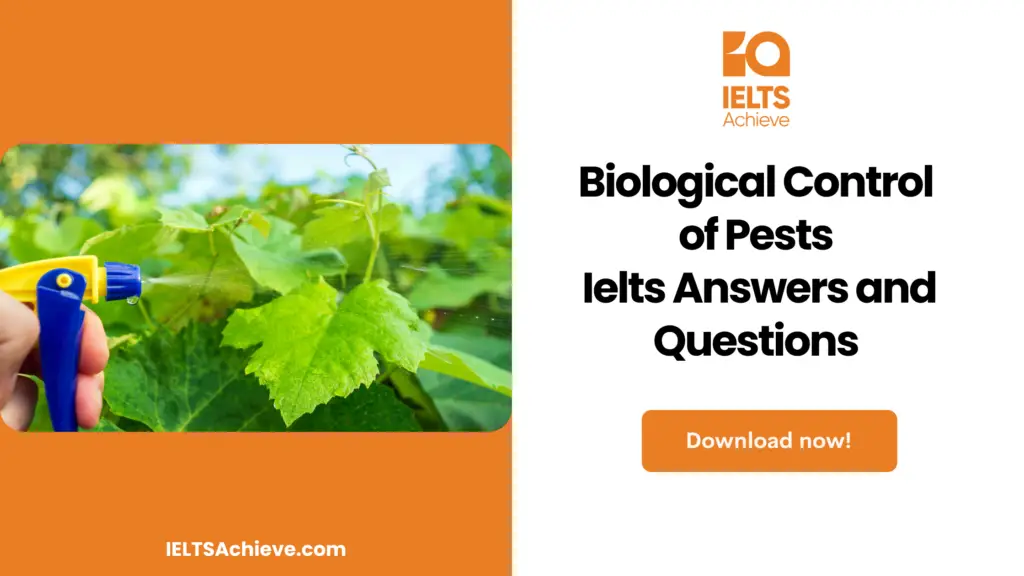
IELTS Reading Passage – Biological Control of Pests
Biological Control of Pests
The excessive usage of synthetic chemicals to control the pests eventually poses a serious threat to the crops and human’s health system, and it seems to be not productive at all. The use of pesticides has caused not only dangerous ecological imbalance but also gave birth to the new breed of chemical-resilient superbugs that are highly deadly. Based on a new research conducted by the Food and Agriculture Organisation (FAO), it was found that nearly 300 plus species of agricultural pests have become resilient to a huge variety of chemicals. Currently, the disease-spreading pests have developed a concept of no one left behind. More than 100 species have attained complete immunity for a wide range of insecticides that are in use.
One of the biggest cons of using pesticides is that it kills all the harmful pests along with many other organisms that are useful for crop cultivation. It, however, keeps the spread of the pest population under control. Many agro scientists and ecological experts call this scenario the ‘treadmill syndrome’. Due to this overwhelming potential and genetic diversity, most pests are able to combat any form of synthetic chemical and handle the offspring supported by the intense resistance from the pesticides.
The consequences of the ‘treadmill syndrome’ are witnessed in Central America, where cotton farmers suffered a lot. In the 1940s time period, when chemical-oriented intensive agriculture was at its best, the farmers shifted to the usage of pesticides in order to yield more crops in the same amount of time. Over a period of time, insecticides were used eight times a year in the 1940s, and it was increased to 28 times during a season in the mid-1950s. It resulted in the birth of three new variants of chemical-resistant pests.
Near the mid-1960s, four more new variants of pests emerged, causing an alarming stage. It pushed agricultural farmers to spray pesticides to a situation where 50% of the financial output of cotton production was based on using pesticides intensively. Subsequently, this spraying practice reached 70 times per season, which caused yet another pool of genetically better insect species.
Today, the products of pesticides available in the market are not tested properly, where their chemical properties might cause cancer, mutations and other severe damage to human health, as said by environmental agencies located in the United States. The United States National Resource Defence Council revealed that DDT was one of the widely-known dangerous chemicals in the list.
In the overview of the alarming perils from non-discriminative pesticide applications, a more reliable and ecological-based strategy of biological control, including the specific trend of natural rivalries of the pest population, is reaching popularity like never before – even though it is a new scope of area with minimum potential. The biggest pro of biological control compared to other methods is that it offers the product in low-cost, having a perpetual control system with less amount of hazardous side effects. When it was experimented by experts, they said that bio-control is good, which is not emitting pollution and self-dispersing.
The Commonwealth Institute of Biological Control (CIBC), situated in Bangalore has its network of scientific laboratories and local stations across the globe. It is one of the most influential, non-commercial research organisations working related to pest control by creating predators against parasites. This research agency also serves as an approving house for the transaction of biological agents for pest control worldwide, including all imports and exports.
The research agency (CIBC) made use of a seed-feeding weevil from Mexico. It was successful in controlling the obnoxious parthenium weed, famous for exerting devious insights on agriculture industry and human health in both Australia and India. Likewise there is one more research laboratory based in Hyderabad called Regional Research Laboratory (RRL), sponsored and supported by CIBC, is presently experimenting an Argentinian weevil to eradicate water hyacinth (the next dangerous weed) which caused serious repercussions in many parts of the world. Mrs Kaiser Jamil from RRL stated that the Argentinian weevil does not damage any other food plant, whereas a set of two adult bugs might destroy the weed in almost 4 – 5 days. Moreover, CIBC is also strengthening the practice of breeding parasites that kill the ‘disapene scale’ insects, being one of the notorious defoliants of fruit trees in countries like India and the US.
Through subsequent examples, we will see how the act of biological control is effective. In the late 1960s time, Sri Lanka’s coconut groves were at a booming stage, however, it was plagued by leaf-mining hispides, a larval type of parasite brought from Singapore, which made the pest stop growing further. Similarly, another natural predator from India, Neodumetia sangawani, was satisfactory in terms of controlling the Rhodes grass-scale insect that was spoiling the life of grass in some parts of the US. There was another beetle native from Brazil, Neochetina bruchi, was used by ecological scientists of the Kerala Agricultural University emptied almost a 12-kilometre-long canal from the main clutches of the weed, called Salvinia molesta, widely-known as “African Payal” in Kerala. Nearly 30,000 and more hectares of rice and its fields were infested by this type of weed in the state of Kerala.
Biological Control of Pests Reading Questions
Questions 1 – 5
The reading passage has nine paragraphs, A – I.
Choose the correct heading for each paragraph from the list of headings given below.
Write the correct number, i-vii, as your answer to each question.
List of Headings
- India’s contribution to CIBC
- Pesticides today
- Treadmill Syndrome and its consequences
- Examples of Biological Control Across the World
- Introduction to CIBC
- Paragraph C
- Paragraph E
- Paragraph G
- Paragraph H
- Paragraph I
Ready to conquer Matching Headings questions? Click here to learn essential tips and techniques for matching headings accurately to paragraphs or sections in the IELTS Reading section.
Questions 6 – 10
Complete the sentences below.
Write NO MORE THAN TWO WORDS from the passage for each answer.
6. This spraying practice reached 70 times per season, which caused yet another pool of ____________ insect species. 7. _________________, was satisfactory in terms of controlling the Rhodes. 8. Many agro scientists and ecological experts call this scenario the _____________. 9. Regional Research Laboratory (RRL), sponsored and supported by CIBC, is presently experimenting with an _________________ to eradicate water hyacinth. 10. They said that bio-control is good, which is not emitting pollution and ____________.
Enhance your sentence completion skills in the IELTS Reading section. Click here to access our comprehensive guide and learn effective strategies for filling in missing words or phrases in sentences.
Questions 11 – 13
Choose the correct letter a, b, c or d.
11. In Kerala, Salvinia molesta is also known as
- African Payal
- Asian Payal
- American Payal
- Indian Payal
12. There was another beetle native to Brazil called as
- Salvinia molesta
- Neodumetia sangawani
- Neochetina bruchi
- None of the above
13. During which time period chemical-oriented intensive agriculture was at its best?
- The 1940s
- The 1950s
- The 1960s
- All of the above
Ready to improve your performance in Multiple Choice Questions (MCQs)? Click here to access our comprehensive guide on how to tackle MCQs effectively in the IELTS Reading section.
Unlock your full potential in the IELTS Reading section – Visit our IELTS Reading Practice Question Answer page now!
Recommended Questions:
Renewable Energy IELTS Reading Question with Answer
Biological Control of Pests Reading Answers Key
1. H
2. E
3. C
4. I
5. G
6. Genetically better
7. Neodumetia sangawani
8. Treadmill Syndrome (h6)
9. Argentinian weevil
10. Self-dispersing
11. a. African Payal
12. c. Neochetina bruchi
13. a. The 1940s

We hope you found this post useful in helping you to study for the IELTS Test. If you have any questions please let us know in the comments below or on the Facebook page.
The best way to keep up to date with posts like this is to like us on Facebook, then follow us on Instagram and Pinterest. If you need help preparing for the IELTS Test, join the IELTS Achieve Academy and see how we can assist you to achieve your desired band score. We offer an essay correction service, mock exams and online courses.


